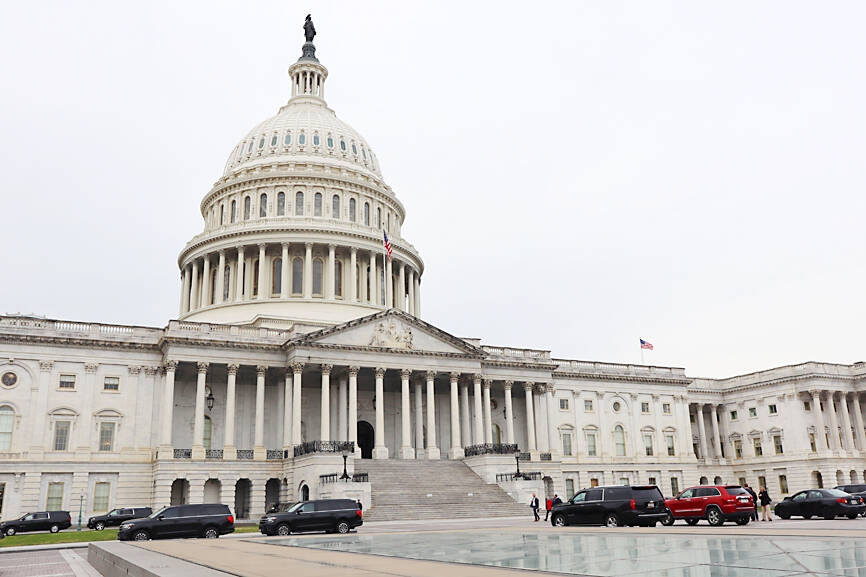The most recent version of the US’ National Defense Authorization Act (NDAA) for Fiscal Year 2025 includes increased support for Taiwan, US House of Representatives Speaker Mike Johnson said yesterday.
Johnson made the remarks at a news conference on Capitol Hill.
The NDAA, published on Saturday, would allow the US departments of defense and state to augment Taiwan’s military capabilities, such as anti-armor, radars, crewed and uncrewed aerial vehicles, cyberdefense, long-range precision weapons, integrated air and missile defense systems, anti-ship missiles, electronic warfare and counter-electronic warfare capabilities, secure communications equipment and other electronic protection systems.

Photo: CNA
The act authorizes a Taiwan Security Cooperation Initiative, modeled after the Ukraine Security Assistance Initiative, to enable Taiwan to maintain sufficient self-defense capabilities consistent with the Taiwan Relations Act. And the lawmakers have proposed military articles and training worth up to US$300 million to support Taiwan in the Act.
In concurrence with the US secretary of state, the secretary of defense may provide Taiwan’s military, government and other agencies with defense articles from the US inventory and services to help the nation maintain sufficient self-defense capabilities, according to the NDAA.
The US is to establish a joint program with Taiwan on general trauma care, amputation and amputee care, and any other mental health condition associated with post-traumatic stress disorder or traumatic brain injuries, it says.
According to Section 1324 of the act, the US Congress can invite Taiwan’s naval forces to participate in next year’s Rim of the Pacific exercise.
According to Section 5121, also known as Building Options for the Lasting Security of Taiwan through European Resolve (BOLSTER) Act, collaborations with the EU and the UK should be pursued on sanctions against the People’s Republic of China (PRC) if it overthrows or dismantles the governing institutions in Taiwan, or occupies any territory controlled or administered by Taiwan.
Imposing a naval blockade or quarantining Taiwan, seizing its outlying islands or initiating a cyberattack that threatens civilian or military infrastructure in the nation are grounds to issue sanctions, according to the BOLSTER Act.
The US president should tender a report to the Senate’s Committee on Foreign Relations and the House of Representatives’ Committee on Foreign Affairs on the expected economic impacts of a Chinese People’s Liberation Army (PLA) 30-day or 180-day blockade or quarantine of Taiwan, according to the NDAA.
The US and European countries should publicly and repeatedly emphasize the differences between their respective “one China” policies and the PRC’s “one China” principle to counter the PRC’s claims that UN Resolution 2758 recognizes the PRC territorial claims to Taiwan, it says.
European countries, particularly those with experience combatting Russian aggression, can provide Taiwan with lessons learned from their defense programs to mobilize the military and civilians in a time of crisis, it says.

The Central Weather Administration (CWA) yesterday said it expected to issue a sea warning for Typhoon Fung-Wong tomorrow, which it said would possibly make landfall near central Taiwan. As of 2am yesterday, Fung-Wong was about 1,760km southeast of Oluanpi (鵝鑾鼻), Taiwan’s southernmost point, moving west-northwest at 26kph. It is forecast to reach Luzon in the northern Philippines by tomorrow, the CWA said. After entering the South China Sea, Typhoon Fung-Wong is likely to turn northward toward Taiwan, CWA forecaster Chang Chun-yao (張峻堯) said, adding that it would likely make landfall near central Taiwan. The CWA expects to issue a land

Taiwan’s exports soared to an all-time high of US$61.8 billion last month, surging 49.7 percent from a year earlier, as the global frenzy for artificial intelligence (AI) applications and new consumer electronics powered shipments of high-tech goods, the Ministry of Finance said yesterday. It was the first time exports had exceeded the US$60 billion mark, fueled by the global boom in AI development that has significantly boosted Taiwanese companies across the international supply chain, Department of Statistics Director-General Beatrice Tsai (蔡美娜) told a media briefing. “There is a consensus among major AI players that the upcycle is still in its early stage,”

The Central Weather Administration (CWA) yesterday said it is expected to issue a sea warning for Typhoon Fung-wong this afternoon and a land warning tomorrow. As of 1pm, the storm was about 1,070km southeast of Oluanpi (鵝鑾鼻), Taiwan’s southernmost point, and was moving west-northwest at 28 to 32kph, according to CWA data. The storm had a radius of 250km, with maximum sustained winds of 173kph and gusts reaching 209kph, the CWA added. The storm is forecast to pass near Luzon in the Philippines before entering the South China Sea and potentially turning northward toward Taiwan, the CWA said. CWA forecaster Chang Chun-yao (張峻堯) said

Japanese Prime Minister Sanae Takaichi yesterday said that China using armed force against Taiwan could constitute a "survival-threatening situation" for Japan, allowing the country to mobilize the Japanese armed forces under its security laws. Takaichi made the remarks during a parliamentary session while responding to a question about whether a "Taiwan contingency" involving a Chinese naval blockade would qualify as a "survival-threatening situation" for Japan, according to a report by Japan’s Asahi Shimbun. "If warships are used and other armed actions are involved, I believe this could constitute a survival-threatening situation," Takaichi was quoted as saying in the report. Under Japan’s security legislation,